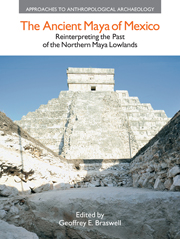Book contents
- Frontmatter
- Dedication
- Contents
- Contributors
- List of Figures
- List of Tables
- 1 The Ancient Maya of Mexico: Reinterpreting the Past of the Northern Maya Lowlands
- Part I THE PRECLASSIC PERIOD
- Part II THE EARLY AND LATE CLASSIC PERIODS
- Part III THE TERMINAL CLASSIC AND EARLY POSTCLASSIC PERIODS
- Part IV THE LATE POSTCLASSIC TO HISTORICAL PERIODS
- Part V CONCLUSIONS
- 14 Yucatan at the Crossroads
- Index
14 - Yucatan at the Crossroads
from Part V - CONCLUSIONS
- Frontmatter
- Dedication
- Contents
- Contributors
- List of Figures
- List of Tables
- 1 The Ancient Maya of Mexico: Reinterpreting the Past of the Northern Maya Lowlands
- Part I THE PRECLASSIC PERIOD
- Part II THE EARLY AND LATE CLASSIC PERIODS
- Part III THE TERMINAL CLASSIC AND EARLY POSTCLASSIC PERIODS
- Part IV THE LATE POSTCLASSIC TO HISTORICAL PERIODS
- Part V CONCLUSIONS
- 14 Yucatan at the Crossroads
- Index
Summary
Inspired by a flurry of new fieldwork in Yucatan, by the chapters in this book, and by Geoff Braswell's request that I write about the directions Maya archaeology might take, I will review what we have learned and suggest how we might move forward.
The Yucatan Peninsula is divided among three Mexican states: Yucatan, Campeche, and Quintana Roo. It comprises almost 200,000 square kilometers, or two-thirds of the Maya region. Yucatan, however, receives neither two-thirds of all funding nor two-thirds of the attention of Maya archaeologists. For these and other reasons, mentioned below, it is not surprising that the story of the northern Maya lowlands is less well documented than that of the southern lowlands.
Indeed, when the term “Maya” is mentioned, most people immediately think of the southern lowlands, with its myriad cities, giant temples, and white roof-combs poking up through the green rainforest, and its thousands of hieroglyphic texts providing the names, deeds, and rites of Maya kings and queens. Many young archaeologists arrive in the southern lowlands, fall in love with it, and cannot imagine leaving it for another region. Still others begin in the northern lowlands, grow tired of the dense secondary growth and the acahuales, and end up going to the southern lowlands.
- Type
- Chapter
- Information
- The Ancient Maya of MexicoReinterpreting the Past of the Northern Maya Lowlands, pp. 349 - 372Publisher: Acumen PublishingPrint publication year: 2012



